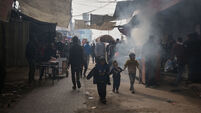More troops sent to bolster Afghan mountain battle
Afghan troops and tanks rushed to the mountain battle zone today to bolster US led coalition forces against determined pockets of al-Qaida militants fulfilling their vow to fight to the death.
‘‘I have not seen anyone surrender,’’ said Colonel Frank Wiercinski, a brigade commander in the 101st Airborne Division.














